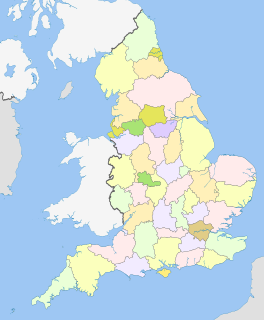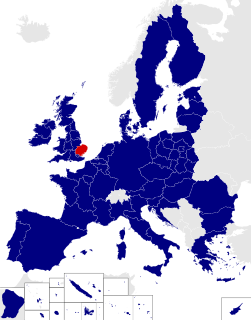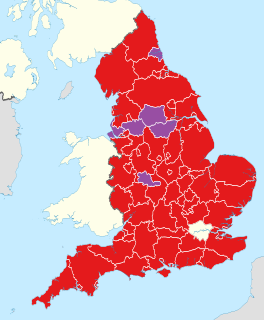Related Research Articles

The East of England is one of the nine official regions of England. This region was created in 1994 and was adopted for statistics purposes from 1999. It includes the ceremonial counties of Bedfordshire, Cambridgeshire, Essex, Hertfordshire, Norfolk and Suffolk. Essex has the highest population in the region.

The subdivisions of England constitute a hierarchy of administrative divisions and non-administrative ceremonial areas.

The counties of England are areas used for different purposes, which include administrative, geographical, cultural and political demarcation. The term "county" is defined in several ways and can apply to similar or the same areas used by each of these demarcation structures. These different types of county each have a more formal name but are commonly referred to just as "counties". The current arrangement is the result of incremental reform.

The counties and areas for the purposes of the lieutenancies, also referred to as the lieutenancy areas of England and informally known as ceremonial counties, are areas of England to which lords-lieutenant are appointed. Legally, the areas in England, as well as in Wales and Scotland, are defined by the Lieutenancies Act 1997 as "counties and areas for the purposes of the lieutenancies in Great Britain", in contrast to the areas used for local government. They are also informally known as "geographic counties", to distinguish them from other types of counties of England.

A non-metropolitan county, or colloquially, shire county, is a county-level entity in England that is not a metropolitan county. The counties typically have populations of 300,000 to 1.8 million. The term shire county is, however, an unofficial usage. Many of the non-metropolitan counties bear historic names and most, such as Wiltshire and Staffordshire, end in the suffix "-shire". Of the remainder, some counties had the "-shire" ending but have lost it over time, such as Devon and Somerset.

Cambridgeshire Constabulary is the local territorial police force that covers the county of Cambridgeshire and Peterborough unitary authority. It provides law enforcement and security for an area of 1,311 square miles (3,400 km2) and population of 856,000 people, in a predominantly rural county. The force of Cambridgeshire includes the cities of Cambridge, Ely and Peterborough, the market towns of Chatteris, Huntingdon, March, Ramsey, St Ives, St Neots, Whittlesey, and town and Port of Wisbech. Its emblem is a crowned Brunswick star containing the heraldic badge of Cambridgeshire County Council.

East of England was a constituency of the European Parliament that was coterminous with the East of England region. It returned 7 MEPs using the D'Hondt method of party-list proportional representation, until the UK exit from the European Union on 31 January 2020.

Metropolitan and non-metropolitan counties are one of the four levels of subdivisions of England used for the purposes of local government outside Greater London and the Isles of Scilly. As originally constituted, the metropolitan and non-metropolitan counties each consisted of multiple districts, had a county council and were also the counties for the purposes of Lieutenancies. Later changes in legislation during the 1980s and 1990s have resulted in counties with no county council and 'unitary authority' counties with no districts. Counties for the purposes of Lieutenancies are now defined separately, based on the metropolitan and non-metropolitan counties.
England is divided by a number of different regional schemes for various purposes. Since the creation of the Government Office Regions in 1994 and their adoption for statistical purposes in 1999, some historical regional schemes have become obsolete. However, many alternative regional designations also exist and continue to be widely used.

Peterborough City Council is the local authority for Peterborough in the East of England. It is a unitary authority, having the powers of a non-metropolitan county and district council combined. The City was incorporated as a municipal borough in 1874; from 1888, it fell within the jurisdiction of the Soke of Peterborough county council and from 1965, Huntingdon and Peterborough county council. In 1974, it was replaced by a wholly new non-metropolitan district, broadly corresponding to the Soke, in the new enlarged Cambridgeshire. In 1998, Peterborough became independent of Cambridgeshire as a unitary authority, but the city continues to form part of that county for ceremonial purposes as defined by the Lieutenancies Act 1997.
The Local Government Commission for England was established by the Local Government Act 1958 to review the organisation of local government, and make "such proposals as are hereinafter authorised for effecting changes appearing to the Commissions desirable in the interests of effective and convenient local government". Most of the commission's proposals failed to reach consensus and were not implemented, and the body was dissolved in 1967.

The Local Government Commission for England was the body responsible for reviewing the structure of local government in England from 1992 to 2002. It was established under the Local Government Act 1992, replacing the Local Government Boundary Commission for England. The Commission could be ordered by the Secretary of State to undertake "structural reviews" in specified areas and recommend the creation of unitary authorities in the two-tier shire counties of England. The Commission, chaired by John Banham, conducted a review of all the non-metropolitan counties of England from 1993 to 1994, making various recommendations on their future.

BBC East is one of BBC's English Regions covering Norfolk, Suffolk, Cambridgeshire, northern Buckinghamshire, and the majority of Northamptonshire, Bedfordshire, Hertfordshire and Essex. It is headquartered in The Forum, Norwich since 2003. It was also separated into two areas, one with the East area covering mostly in Norfolk, Suffolk & Essex, and another from the West area which covers from Cambridge, serving mostly Cambridgeshire and the three counties.

Scouting in East of England is about Scouting in the official region of East of England. It is largely represented by The Scout Association of the United Kingdom and some Groups of traditional Scouting including the Baden-Powell Scouts' Association.

A combined authority is a type of local government institution introduced in England outside Greater London by the Local Democracy, Economic Development and Construction Act 2009. Combined authorities are created voluntarily and allow a group of local authorities to pool appropriate responsibility and receive certain delegated functions from central government in order to deliver transport and economic policy more effectively over a wider area.
Local transport bodies are partnerships of local authorities in England outside Greater London. There are 38 local transport bodies. They cover similar areas to local enterprise partnerships, but are not permitted to overlap each other. Decision making for major transport infrastructure spending is devolved to these bodies from the Department for Transport. They will receive funding from April 2015.

The Cambridgeshire and Peterborough Combined Authority is a combined authority covering the ceremonial county of Cambridgeshire in the East of England. The authority was established on 3 March 2017. The authority is led by the directly elected Mayor of Cambridgeshire and Peterborough.

Heart East is a regional radio station owned and operated by Global as part of the Heart network. It broadcasts to the East of England from studios in Milton Keynes.
References
- ↑ "The East of England Regional Assembly (EERA) :: End of EERA". Archived from the original on 2011-02-26. Retrieved 2010-06-23.
- ↑ "Local Government In The East of England - About Us - EELGA". www.eelga.gov.uk.